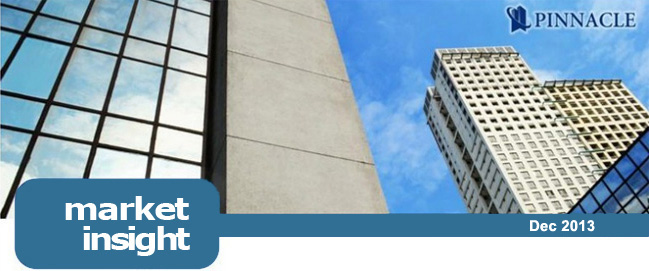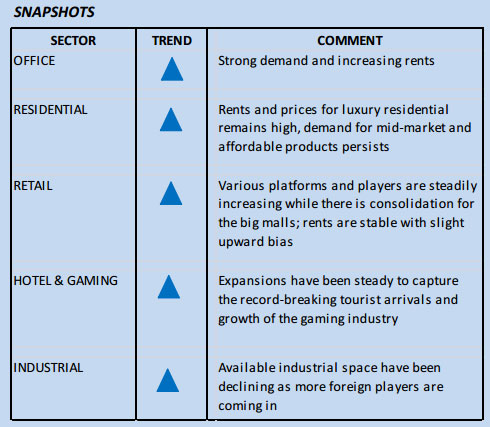
OPPORTUNITIES ARE ABOUND
The Economy

Buoyed by the stable Aquino Administration and its platform for good governance, the Philippines
posted a real Gross Domestic Product (GDP) growth rate of 6.8% in 2012. The recent credit rating
upgrade by Moody’s Investor Services to investment grade (Baa3) reinforces the earlier upgrades from
Fitch’s and S&P’s ratings. While the projected GDP growth rate for 2013 was initially pegged at 7.8%,
this will be adjusted due to the devastations caused by Typhoon Yolanda. Based on initial estimates, the
annualized GDP growth rate will still be in the high 6% hovering to 7%. The average GDP growth rate for
most of the Association of Southeast Asian Nations (ASEAN) for last year, and the projected GDP growth
for this year is 6%. Thus, even with the negative impacts of Typhoon Yolanda, the Philippines is still at
par with or even has a slightly higher growth rate than most ASEAN countries.
The average annual bank interest rate is a very good indicator of stability of available capital, as well as
business sentiment. In the past five years, the single-digit interest rate regime has been experienced.
Starting with high 8% from 2007 to 2009, it has been dipping to 6% since 2011 up to the present.
Likewise, inflation rate is another good gauge of business activities. While inflation rate spiked to over
8% in 2008, since 2009, inflation rate has been averaging 4% and is projected to dip to 3% this year.
The Philippine Peso to US Dollar exchange is a popular indicator of economic health given that the
Philippines is strongly tied to the US economy, and most imports and exports are done with US Dollars.
The exchange has been generally stable with a slight bias to a stronger Peso, presumably due to the
lingering weakness of the US economy in recent years. Moreover, dollar has been steadily generated
from business process outsourcing and stable overseas Filipino remittances. As of September 2013,
total remittances reached US$16.48 billion, which is 5.84% higher for the same period last year.
The total Visitor Arrivals by August of this year breached the
three million-mark, at 3,180,903, which is 11.28% higher for
the same period last year. The 3.18 million arrivals is also
another record as it is the first time that visitor arrivals
reached the three million mark in the month of August.
More importantly, the Philippine Economic Zone Authority
(PEZA) investments from January to October this year
increased by 38.5% (year-on-year), and reached Php 150.91
billion. This is a testament to the increasing attractiveness of
the Philippines given that the total foreign direct investments
in 2012 grew by 42.68%.
All of these key indicators translate to robust economic
fundamentals and sound investment environment. In turn, the
macroeconomics fuels the strong demand for the different
sectors in the property market.
Office Market
The demand for office spaces in Metro Manila is still very
robust, with occupancy rates ranging from 94% to 98% in the
different business districts. The BPOs’ continued expansion
represents the biggest demand driver. Developers are pushing
ahead with their projects to capture this pent-up demand.
Rents have been inching up, even with new buildings coming
online, due to the tight supply. Thus, the market has been seeing pre-leasing again especially from big occupiers to avoid
the space crunch. While Ortigas, Alabang and Quezon City
offer alternative sites, Makati CBD and BGC remain as the
preferred office locations.
Since Makati remains the location of headquarters of major
companies and global businesses, developers and investors
have been looking for old buildings that can be renovated or
re-developed. Some big companies even acquired existing
buildings that can be converted for their own use and
occupancy. While rental rates are increasing due to space
limitations, these are still within tolerable limits. Rents in
Premium Grade A are still slightly higher than Php 1,000 per
sqm per month, while rents in Grade A have an average of Php
750 per sqm per month. Small and old buildings in Makati are
offering rents at an average of Php 550 per sqm per month.
The very strong demand for Fort Bonifacio Global City (BGC)
lots has pushed accommodation values even higher than in
Makati land values, since most lots in BGC are below the 16-
floor area ratio (FAR). BGC is indeed the preferred location of
BPOs. The interest in BGC’s office market has further
thickened with the recent acquisition of five buildings of the
Net Group by no other than SM Group, at an estimated tag
price of Php 18 billion. Meanwhile, asking prices in BGC are
way above the Php 30,000 accommodation value. The cross
section at BGC, however, does not directly compete with
Makati CBD. Makati still caters to the corporates and
traditional offices, while BGC buildings (green and all) mainly
cater to BPOs. BGC and Makati are actually complementing
one another, which is a welcome decongestion of Makati CBD.
Residential Market
While various developers have been more discerning with
their project launches, the residential market continues to be
very active. The high-end segment remains to be strong and
top brands of the Ayala, Century Properties, Filinvest,
Robinsons, and Rockwell Groups have been introducing
products catering to the rich and famous. It is no wonder that rents in luxury high-end condo units are
well above Php 200,000 per month,
depending on the floor areas. Rents in the
villages, given the very limited supply,
remain to be strong ranging from Php
300,000 to Php 500,0000 per month.
For the mid-market and affordable
segments, the prevailing low interest rates
and high liquidity allow both developers and
buyers access to various financing schemes.
Various developers continue to tap the
availability of financing from the banks and
even from international players. These
financing institutions assure them access for
land banking as well as to complete their
ongoing residential projects. This highly
liquid regime likewise gives their projects a
better likelihood of being sold as this would
open their units for sale to a larger market,
locally and internationally.

Retail Market
The Filipinos’ affinity to malls and their propensity to spend have been keeping the retail owners with
enviable cash liquidity. Retail owners have been raking in from overseas Filipinos and their families, and
from the ever-increasing number of BPO employees. Even for self-employed or small businessmen, or
the traditional employees, disposable incomes continue to rise over time and these incomes funnel to
the malls. With a lot of office and residential developments, various retail platforms have been
introduced as well, such as the mini-grocery and convenience store setups. Some developers have
either setup their own retail division or forged alliance with well-known retailers.
Retail malls are still controlled by a few big players. Recently, ownership or strategic alliances have been
shifting, mainly brought about by the strategic plays of the key players. Early this year, the SM and
Walterwart Groups structured a joint venture to counter the aggressive moves of Puregold Price Club
Inc., which includes S&R Membership Shopping. Puregold, apart from its recent fray in the Philippine
Stock Market, also acquired four operating Eunilaine foodmarts and its 11 operating “Grocer E
supermarts”. Other strategic retailers are the Araneta, Ayala, Federal, Filinvest, Greenfield, Kuok,
Metro-Gaisano, Ortigas, Robinsons, Rockwell, Sta. Lucia, and Star Groups.
Successful retailers have been dictating lease rates, terms and
conditions of occupancy, delivery, and even control the supply
chain, thereby, putting pressure on the suppliers to lower cost. As
in the previous years, retail malls have been generating one of
the highest, if not the highest yields, in the property sector. It is
projected that further consolidation shall happen in major retail
platforms, and niche players would continue to look for untapped
platforms in specialized markets.
Hotel and Gaming Market
The hotel market has been benefitting from the steady rise of the
Philippine tourism industry. It is interesting to note the recent
race to put flags in major CBDs, such as the Holiday Inn and
Fairmont in Makati, Grand Hyatt and Shangri-la in BGC; and some
chains like the Ascot Group and the affordable Tunes Hotels have
been busy criss-crossing the CBDs. The biggest driver, however, is
the booming Gaming industry. The success of the Resorts World
Manila (Megaworld Group) and Solaire Manila (Bloombery
Resorts) had reverberated to the big players. Large-scale projects
are now underway mainly in the “Bay Area” and airport area.
Given the requirement of the Philippine Amusement and Gaming
Corporation (PAGCOR) to put up hotel rooms in exchange of
gaming licenses, a lot of quality supply of hotel rooms would be
sprouting.
On the demand side, record-breaking tourist arrivals have been
happening almost every year. For 2013, it is the first time that the
3 million-barrier, a pipe-dream a decade ago, was breached as
early as the month of August. More importantly, the Department
of Tourism has been lining up major international and interregional events for the Philippines, such as hosting the Asia-Pacific Economic Cooperation Summit in 2015. Bilateral (e.g.
Philippine-Brazil no-VISA travel) and multilateral (e.g. ASEAN
integration) arrangements would further boost the influx of
tourist in the Philippines.
Industrial Market
The Philippine Economic Zone Authority has been harping that
vacancies in PEZA parks have been declining and there have been steady inquiries on the Philippine industrial market. While one
has to take this with a grain of salt, the bell-weather of industrial
market is the combined market of the Clark Special Economic
Zone (CSEZ) and the Subic Bay Freeport Zone (SBFZ). Officially,
CSEZ has a total area of approximately 29,000 hectares while
SBFZ has a total area of about 67,000 hectares. In terms of real
space for lease, the Clark Development Corporation (CDC) is
leasing a total area of approximately 116 hectares while the Subic
Bay Metropolitan Authority (SBMA) is only leasing a total area of
51 hectares.
In terms of demand, CSEZ has approximately 1,100 locators, and
SBFZ has a total of 600 locators. The success of both Clark and
Subic has been through identifying major tenants that would sublease to smaller tenants. In the case of CSEZ, CDC leased big
spaces to Berthaphil Inc., Global Gateway Development Corp.,
and PhilExcel Business Park Inc. The SMBA leased big areas to the
Japanese-developed Subic Technopark and the Taiwanese-driven
Subic Gateway.
Strategic Opportunities
The Office Sector shall remain a favourite given the very tight
office supply. Developers and landlords should take advantage of
the “pre-leasing” phenomenon to fill up their spaces, and/or fast track their constructions. Yields shall remain strong and could
easily out-pace interest rates. The major decision points are what
market to target (BPOs or traditional companies); what
technology to use (green or traditional building); and what
percentage to sell (pre-leasing or pre-selling). The Ayala and
Century Groups have been benefitting from pre-selling of office
spaces.
Commercial spaces offered by the retailers shall continue to
enjoy the highest yields. Retail malls have been expanding their
tenant-mixes that include major government offices and
collection agencies to attract more and more foot traffic. The
general concept is to attract shoppers in the mall and keep them
in for as long as possible by offering various services and products. For niche players, they should consider
location-specific opportunities, especially for smart
shoppers that avoid long queues and tight parking in
malls, and prefer relaxed shopping and dining.
The Residential Sector is highly opportunistic. Luxury
residential development is always resilient but more
expensive to build. Mid-market is very competitive and
location-specific. Demand for affordable and socialized
housing has been north of three million, but the
marketing is based on volume and highly supported by a
number of government agencies, and the margin per
unit is relatively lower. The common trend is mixing
residential with office and retail developments. More
importantly, it is instructive to conduct accurate market
scanning on the sizes, amenities and pricing of the
residential products to be offered; and how much retail
and office spaces to be blended in the mix.
The Hotel Sector has always been a boom-time play.
With the investment grade status of the Philippines and
record tourist arrivals, this is the best time to put up
hotels. The key questions are what “star” to put up
(which is location-specific); would it be owner-operated
or managed by well-known brands; and would the hotel
development co-locate with the casinos or traditional
tourism areas.
The Industrial Sector has been the laggard of the
Property Market for more than a decade. In recent
years, foreign companies have been steadily coming back to the Philippines. The years 2012 and 2013
showed faster growth of foreign direct investments. There are now a number of applications to get
PEZA accreditation for a number of economic zones all over the Philippines.
The Philippines is in a very good position to sustain the upbeat Property Market. Even with the
destruction caused by Yolanda, most players seeing the opportunities after the crisis. The Philippine
government, together with various local and international groups, has generated billions of Pesos for
rehabilitation and reconstruction. All sectors are now indeed growth areas, with some caveats in the
residential and retail segments. Great opportunities are abound, and are supported by real demand,
strong economy, and positive business climate.


